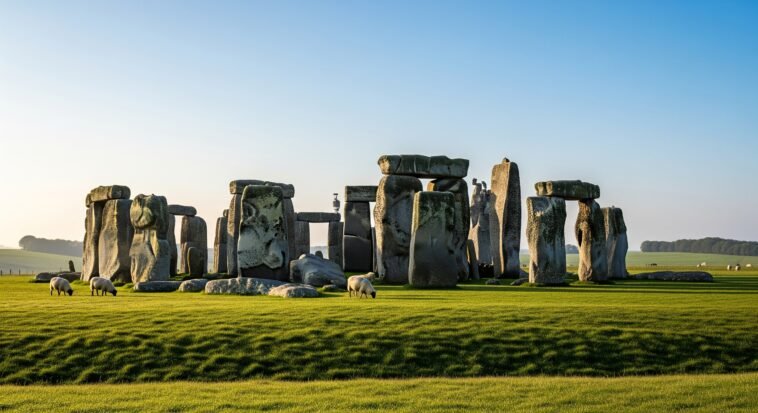
Stonehenge isn’t just a bunch of big rocks—it’s ancient Britain’s mystery MVP.
People used to argue whether it was a graveyard, temple, or alien Wi-Fi tower (kidding… kinda).
But thanks to new digs and science, we’re finally piecing it together: it was likely a spiritual hotspot, a cosmic calendar, and a symbol of unity.
Basically, prehistoric people weren’t just stacking stones—they were syncing with the stars and building community, no Wi-Fi required.
Why Stonehenge Still Captivates Us?
Okay, so here’s the deal—Stonehenge is basically the Beyoncé of ancient monuments.
Everyone knows it, everyone wants to visit it, and no one totally knows how it does what it does.
Global icon
UNESCO gave it the official World Heritage stamp, and tourists still line up like it’s the Taylor Swift Eras Tour of ancient sites.
Enduring mystery
Even with centuries of study, we still don’t fully get how or why they built it.
It’s the OG unsolved mystery—like ancient Britain’s version of Lost, but with fewer polar bears.
Recent breakthroughs
Thanks to new tech and some serious rock nerds (geologists and archaeologists), we’re finally getting closer to the real story—who built it, where the stones came from, and what it actually meant to the people who made it.

- Read also: Uncovering the Secrets of the Past: 10 Fascinating Ancient History Facts
- Read also: Unraveling the Mysteries of Ancient Egyptian Tombs
The Monumental Effort: Building Stonehenge
So, here’s the wild part: Stonehenge isn’t just old—it’s logistically insane.
These folks weren’t just stacking a few rocks.
They pulled off a prehistoric construction project that makes IKEA furniture look easy.
Stones from afar
One of Stonehenge’s most remarkable features is the vast distance its stones traveled:
Sarsen stones
These are the big boys—some weigh 25 tons (aka about 5 elephants).
They came from Marlborough Downs, 20 miles away. No cranes, no trucks, just ropes, logs, and a lot of teamwork.
Bluestones
Smaller but still hefty. These bad boys came from the Preseli Hills in Wales—150 miles away.
People think they dragged or floated them part of the way.
That’s basically ancient Britain’s version of long-distance shipping… without wheels.
Altar stone
Ready for this? It came from northeast Scotland—over 430 miles away. That’s not a typo.
These folks somehow hauled a six-ton stone across rivers, hills, and probably a lot of mud, using nothing but muscle and coordination. Wild.
Engineering and Community
This wasn’t a one-village DIY job.
We’re talking hundreds—maybe thousands—of people working together.
It likely took months (or years), which means it was probably a huge social event, like ancient Glastonbury but with more hauling and fewer guitars.
The scale of the build tells us Stonehenge wasn’t just important—it was important enough for people from all over Britain to show up and work together. That’s major.
New Evidence: Stonehenge as a Monument of Unity
Turns out, Stonehenge wasn’t just about aligning with the stars—it was about aligning with each other.
New research (shoutout to Archaeology International and Professor Mike Parker Pearson) suggests Stonehenge was a massive unity flex.
Like, “let’s bring all the tribes together and make something epic” kind of vibe.
Unifying ancient Britain
The stones came from all over the place—Wales, southern England, even Scotland.
No other stone circle in Britain did this. It’s like every region brought their own piece to the puzzle.
Think of it as ancient Britain’s version of a collab album—except with rocks instead of verses.
So yeah, this wasn’t just spiritual—it was political.
A literal monument saying, “Hey, we’re all part of something bigger.” An ancient group hug, but make it megalithic.
Rituals, feasting, and celebration
Transporting the stones? That was the pre-party.
People probably made a whole event out of it—think festival energy. Archaeologists found signs of massive feasts, ceremonies, and big gatherings.
Picture bonfires, roasted boar, storytelling, and maybe a proto-DJ with a bone flute.
The journey itself may’ve been part of the ritual—a shared mission that united people across distances.
It wasn’t just about building a monument—it was about building connection.

Spiritual and Astronomical Significance
Okay, so beyond being a rockstar group project, Stonehenge was also kind of the ancient world’s version of a planetarium-meets-temple-meets-graveyard.
It had major cosmic vibes and spiritual meaning baked into its design.
Alignment with the cosmos
These folks weren’t just guessing when to plant crops—they built a literal stone calendar.
Stonehenge lines up perfectly with the sunrise on the summer solstice and sunset on the winter solstice.
That’s precision engineering… 4,000+ years ago.
And that’s not all—it also tracks the moon’s movement.
Some archaeologists think they may have even predicted eclipses.
Yep, ancient Britons might’ve been better at space math than your high school physics teacher.
Ancestor worship and ritual center
It wasn’t all star charts and sunlight.
Excavations found human remains buried there, so this place also served as a burial site and spiritual HQ.
Think of it like a sacred gathering spot to connect with ancestors, mark important times of year, and probably do some serious rituals.
Picture Stonehenge lit up by firelight, people chanting under the stars—very Game of Thrones meets National Geographic.
Stonehenge in a Sacred Landscape
Here’s the plot twist: Stonehenge wasn’t just a lone rock diva—it was part of a whole sacred squad.
We’re talking henges, burial mounds (aka barrows), and mysterious ritual sites spread across the landscape like ancient British Pinterest boards for spiritual vibes.
Center of the sacred universe
Stonehenge was the main stage, but it sat in the middle of a much larger spiritual complex.
New finds—like the giant “superhenge” (yes, that’s the actual nickname)—show it was surrounded by monuments that all seemed to “talk” to each other.
Think of it like the ancient version of a city-sized festival ground, with Stonehenge as the headliner.
So yeah, the whole area wasn’t just scenic—it was sacred.
A place where people gathered, remembered their ancestors, marked cosmic events, and probably had some epic torch-lit rituals under the stars.
Theories Revisited: What the New Evidence Means

| Theory | Supported by New Evidence? | Details |
| Astronomical Calendar | Yes |
Solar and lunar alignments confirmed by modern studies.
|
| Burial Site | Yes |
Human remains and ritual artifacts found on site.
|
| Healing Center | Possible |
Bluestones’ origins and folklore suggest healing associations.
|
| Unification Monument | Strongly Supported |
Stones from distant regions, communal effort, and recent studies.
|
| Druid Temple | Unlikely |
Built long before Druids; modern gatherings are a revival.
|
- Read also: Unearthing the Past: A Glimpse into Ancient Roman Artifacts
- Read also: Old World Construction: 8 Architectural Marvels of Ancient Empires
Frequently Asked Questions
Stonehenge was constructed in several stages between 3000 and 1520 BCE, using massive stones transported from as far as Scotland and Wales. The building process required advanced engineering skills and the collective effort of large communities.
The enormous effort to transport and erect the stones suggests Stonehenge held immense cultural, spiritual, and political significance. New evidence points to its role as a unifying monument, bringing together disparate groups in a shared project and celebration.
Absolutely. Stonehenge continues to inspire gatherings, especially during the solstices, and remains a powerful symbol of Britain’s ancient heritage.
Conclusion: Stonehenge—A Legacy of Unity and Wonder
Stonehenge wasn’t just a random stone circle in a field.
It was a massive group project that brought ancient Brits together, synced with the stars, and sat at the heart of an entire spiritual zone.
Thousands of years later, it still hits differently—reminding us that even without Wi-Fi, drones, or group chats, our ancestors pulled off something timeless.



